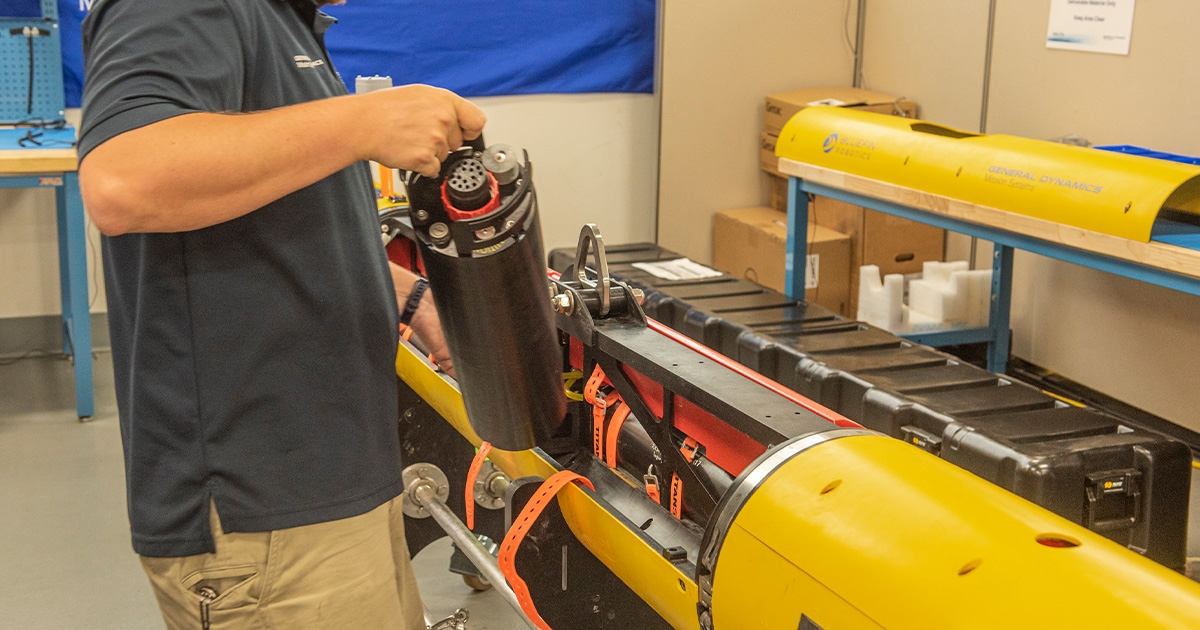The Future of Ocean Connectivity Demands a New Network for Undersea Autonomous Platforms and Sensors

New technologies have long driven the need to improve the networks that carry data between them. You need look no further than the growth and expansion of commercial Internet and 5G wireless cellular data to find a quintessential example of the network backbone advancing to meet new information demands.
We are reaching a level of maturity for unmanned and autonomous systems that their success and effectiveness in military operations is increasingly dependent on the U.S. and its allied nations ability to connect their disparate autonomous systems to achieve the desired mission effects. This requires a fully integrated and interoperable network that works seamlessly between the various command echelons, from dispersed and disadvantaged tactical units to theater-level combatant commanders.
The sophistication of modern autonomous platforms and payloads is dazzling. The capability to operate over-the-horizon has been a game changer for these systems, increasing their reach, and quickening the tempo of military operations. Steady improvements in processing and moving data to decision makers has become the norm in air, ground, and surface operational environments striving to be seamless and as close to real-time as possible to impact mission plans and ensure mission success.
Unmanned Underwater Vehicles and other subsea capabilities must move in a similar direction. The next level of maturity in these systems will be the completion of a robust, flexible, and secure subsea network that ties in afloat and ashore operations centers, enabling migration of mission data generated by the sensors off these platforms, and back to mission partners in a timely manner. A modern seabed network that connects unmanned systems is not only feasible, it is necessary to achieve the full potential of unmanned systems below the water.
SEABED NETWORK EFFICIENCIES
Today, most underwater vehicles are recovered, and their data recorders removed to retrieve the data for analysis. Exchanging data recorders and batteries takes time and removes the vehicles from the operational environment resulting in a loss of on-station mission execution time. If data is desired to be transmitted prior to recovery, then the data is generally transmitted to a platform by means of acoustic modems. Current acoustic modem data rates are low, and the acoustic information must be received and relayed from a surface gateway buoy or other means to a manned or unmanned aircraft, or via space to a satellite and back to Earth.
Over-reliance on satellites has long been recognized as a potential point-of-failure in military communications. In the heat of a conflict, satellites are likely destroyed or severely degraded by opposing forces. Subsea infrastructure maintains a distinct advantage in this space, acting as a resilient method of connecting a variety of assets back to commanders. The scientific and oil and gas industries have long utilized cabled networks to communicate from deployed platforms to shore. Consisting of shore-based trunks, hard-wired cables, and subsea nodes, such networks have been vital to these enterprises. Undersea networks for military applications exist today that can provide power and large data throughput capabilities. The challenges and opportunities are in the ability for these networks to be integrated with various unmanned systems.
INFRASTRUCTURE-AS-A-SERVICE
A future network must include increased use of near-field communications or high-endurance physical connections that provide higher throughput than traditional subsea communications techniques like acoustics. To provide truly resilient and robust mission capabilities, we must expand our undersea infrastructure to provide power and data capabilities that are required to exploit the full potential of our maturing manned and unmanned systems. This infrastructure-as-a-service approach would give undersea assets new-found flexibility and time-to-action for data exfiltration. It would provide the ability to extend missions without the cumbersome and conspicuous operations required to recharge today. And it would realize the benefit of the edge processing improvements being implemented on-board unmanned platforms today, enabling a streamlined offload and subsequent transmittal of only relevant and necessary information.
ONGOING INVESTMENT
If we are not as equally focused today on maturing the network that will ultimately connect our undersea systems together, we will never be able to realize the full potential of these rapidly advancing platforms and systems. While there are still many obstacles to overcome as we field a growing fleet of unmanned undersea vehicles, there can be no doubt that they represent the future of undersea warfare and the technology is maturing faster than our ability to adapt our operations to maximize their value.
A very important first step to address this is to deploy a network that will allow for these assets to maximize their availability and utility and reduce the time it takes to access their mission data. Many of these network capabilities exist today, but we must accelerate their adoption into the undersea domain and improve our ability to transmit data to and from this network if we are to realize the full potential of our expanding undersea systems.
For more information, visit: www.gd.com.
This story was originally featured in ON&T Magazine's Special December 2021 issue. Click here to read more.

